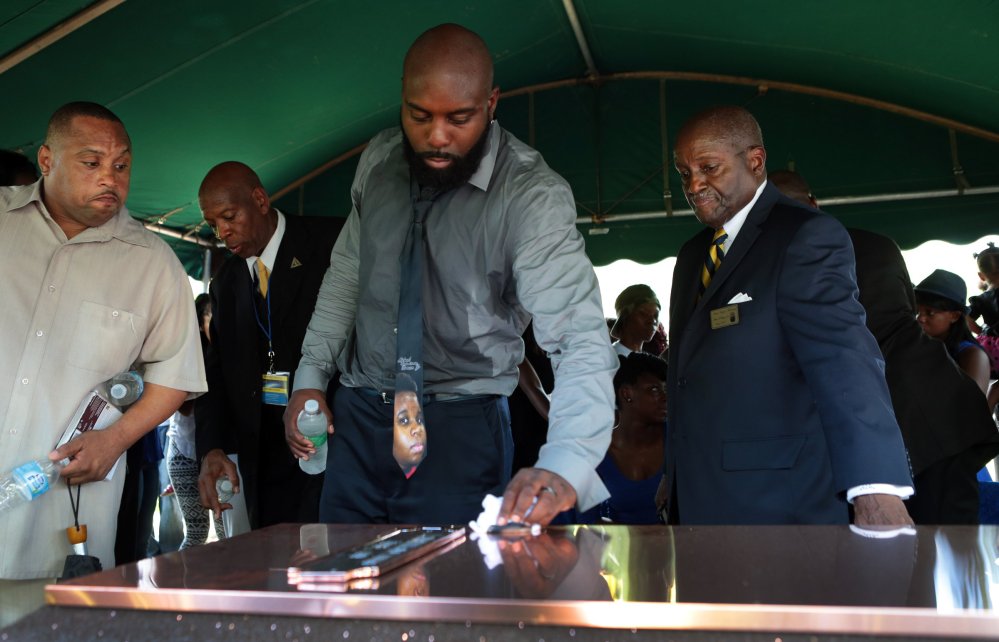ST. LOUIS – The mourners filled an enormous church to remember Michael Brown – recalling him as a “gentle giant,” aspiring rapper and recent high school graduate on his way to a technical college.
But the funeral that unfolded Monday was about much more than the black 18-year-old who lay in the closed casket after being shot to death by a white police officer. The emotional service sought to consecrate Brown’s death as another in the long history of the civil rights movement and implored black Americans to change their protest chants into legislation and law.
“Show up at the voting booths. Let your voices be heard, and let everyone know that we have had enough of all of this,” said Eric Davis, one of Brown’s cousins.
The Rev. Al Sharpton called for a movement to clean up police forces and the communities they serve.
“We’re not anti-police. We respect police. But those police that are wrong need to be dealt with just like those in our community that are wrong need to be dealt with,” Sharpton said.
Two uncles remembered how Brown had once predicted that someday the whole world would know his name.
“He did not know he was offering up a divine prophecy,” Bernard Ewing said.
More than 4,500 mourners filled Friendly Temple Missionary Baptist Church in St. Louis for the service, which at times seemed like a cross between a gospel revival and a rock concert. It began with upbeat music punctuated by clapping. Some people danced in place.
The crowd included the parents of Trayvon Martin, the unarmed 17-year-old African-American fatally shot by a neighborhood watch volunteer in Florida, along with a cousin of Emmitt Till, a 14-year-old murdered by several white men while visiting Mississippi in 1955. Till’s killing galvanized the civil rights movement.
Also in attendance were several White House aides, the Rev. Jesse Jackson, moviemaker Spike Lee, entertainer Sean Combs and some children of the Rev. Martin Luther King.
The Rev. Charles Ewing, the uncle who delivered the eulogy, said Brown “prophetically spoke his demise.” And now his blood is “crying from the ground. Crying for vengeance. Crying for justice.”
Poster-size photos of Brown, wearing headphones, were on each side of the casket, which had a St. Louis Cardinals ball cap atop it. Large projection screens showed a photo of him clutching his high school diploma while wearing a cap and gown. Two days after his death, he had been scheduled to start training to become a heating and air-conditioning technician.
Brown, who was to be buried in a St. Louis cemetery, was unarmed when he was killed. A grand jury is considering evidence in the case, and a federal investigation is also underway.
Police have said a scuffle broke out Aug. 9 after officer Darren Wilson told Brown and a friend to move out of the street and onto a sidewalk in the St. Louis suburb of Ferguson. Police said Wilson was pushed into his squad car and physically assaulted. Some witnesses have reported seeing Brown’s arms in the air in an act of surrender. An autopsy found he was shot at least six times.
Relatives denounced a video released by police, who say it shows Brown snatching cigars from a convenience store just before he was killed. In the video, the person said to be Brown grabs a clerk by the shirt and forcefully pushes him into a display rack.
Sharpton also took the black community to task, saying it should be as upset about black-on-black crime as it is about police violence: “We have to be outraged by our disrespect for each other.”
“Blackness,” he added, “has never been about being a gangster or a thug.”
Money and possessions mean little, he said, “if we can’t protect a child walking down the street in Ferguson” and bring justice.
Brown’s death fueled nearly two weeks of sometimes-violent street protests in Ferguson. His father, Michael Brown Sr., asked protesters to observe a “day of silence” Monday to let the family grieve.
The request appeared to be honored. At the Ferguson Police Department, where a small but steady group of protesters have stood vigil, a handmade sign announced a “break for funeral.” On Monday afternoon, the West Florissant Avenue commercial corridor was also devoid of protesters, whose ranks have typically swelled as days turned to nights.
After the service, Corey Thomas, a 34-year-old St. Louis man, said the large crowd at the church reflected “that people are tired of being treated like dogs. They’re tired of being taken advantage of.”
The mourners came to show their support because “it could be any one of us,” Thomas said.
Angela Pierre, a machine operator who once lived in Ferguson, said she hopes the funeral helps turn a page and eases tensions. Most important, she hopes it provides healing for Brown’s family.
“I really wanted to just be here today to pray for the family and pray for peace,” said Pierre, 48, who is black. “When all of this dies down, there’s still a mother, father and a family who’s lost someone. Sometimes a lot of the unrest takes away from that.”
Monday also marked the first day back at school for students in the Ferguson-Florissant School District. Classes had been scheduled to begin Aug. 14 but were postponed because of safety concerns.
“We’re ready to move forward,” said Marcus Baker, a junior at McCluer South-Berkeley High School. “But we’re still going to remember him.”
Associated Press writer Alan Scher Zagier and video journalist Alex Sanz contributed to this report from Ferguson.
Send questions/comments to the editors.



